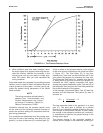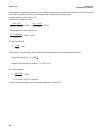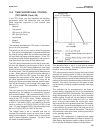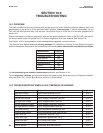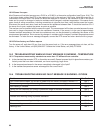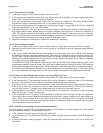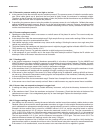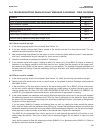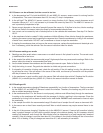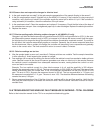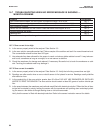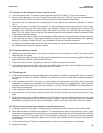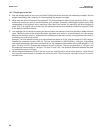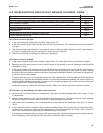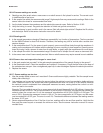
MODEL 54eA SECTION 16.0
TROUBLESHOOTING
16.5 TROUBLESHOOTING WHEN NO FAULT MESSAGE IS SHOWING - FREE CHLORINE
16.5.1 Zero current is too high
A. Is the sensor properly wired to the controller. See Section 3.3.
B. Is the zero solution chlorine-free? Take a sample of the solution and test it for free chlorine level. The con-
centration should be less than 0.02 ppm.
C. Has adequate time been allowed for the sensor to reach a minimum stable residual current? It may take sev-
eral hours, sometimes as long as overnight, for a new sensor to stabilize.
D. Check the membrane for damage and replace it if necessary.
E. Is the cathode coated with copper? (Applies to 498CL-01 sensor only.) If the 498CL-01 sensor is allowed to
operate in a non-flowing sample for more than about an hour, copper from the corrosion of the copper auxil-
iary electrode can diffuse into the sensor a plate out on the cathode. The cathode will appear tarnished and
the zero current will be high. Clean the cathode by soaking in dilute nitric acid. See the sensor instruction man-
ual for details.
16.5.2 Zero current is unstable
A. Is the sensor properly wired to the analyzer? See Section 3.3. Verify that all wiring connections are tight.
B. Readings are often erratic when a new or rebuilt sensor is first placed in service. Readings usually stabilize
after about an hour.
C. Is the conductivity of the zero solution correct for the sensor being used? For a 499ACL-01 free chlorine sen-
sor the zero solution should be deionized water containing a small amount of sodium chloride to give a con-
ductivity greater than 50 uS/cm. DO NOT USED DEIONIZED WATER WITH THE 499ACL-01 SENSOR. For
a 498CL-01 pH-independent free chlorine sensor, deionized water is appropriate for zeroing.
D. Is the space between the membrane and cathode filled with electrolyte solution and is the flow path between
the electrolyte reservoir and membrane clear? Often the flow of electrolyte and be started by simply holding
the sensor with the membrane end pointing down and sharply shaking the sensor a few times as though shak-
ing down a clinical thermometer.
If you are using a 499ACL-01 sensor and shaking does not work, try clearing the holes around the cathode
stem. Hold the sensor with the membrane end pointing up. Unscrew the membrane retainer and remove the
membrane assembly. Be sure the wood ring remains with the membrane assembly. Use the end of a straight-
ened paper clip to clear the holes at the base of the cathode stem. Replace the membrane.
The 498CL-01 pH-independent free chlorine sensor has a mesh cathode that allows the fill solution to com-
pletely bathe the cathode. There are no small holes to become plugged. Do not attempt to clean the mesh
cathode
Verify that the sensor is filled with electrolyte solution (499ACL-01) or electrolyte slurry (498CL-01). Refer to
the sensor instruction manual for details.
Problem See Section
Zero current was accepted, but the current is out of range 16.5.1
Error or warning message appears while zeroing the sensor (zero current is too high) 16.5.1
Zero current is unstable 16.5.2
Sensor can be calibrated, but sensitivity is out of range 16.5.3
Process readings are erratic 16.5.4
Readings drift 16.5.5
Sensor does not respond to changes in chlorine level 16.5.6
Chlorine reading spikes following rapid change in pH 16.5.7
91



